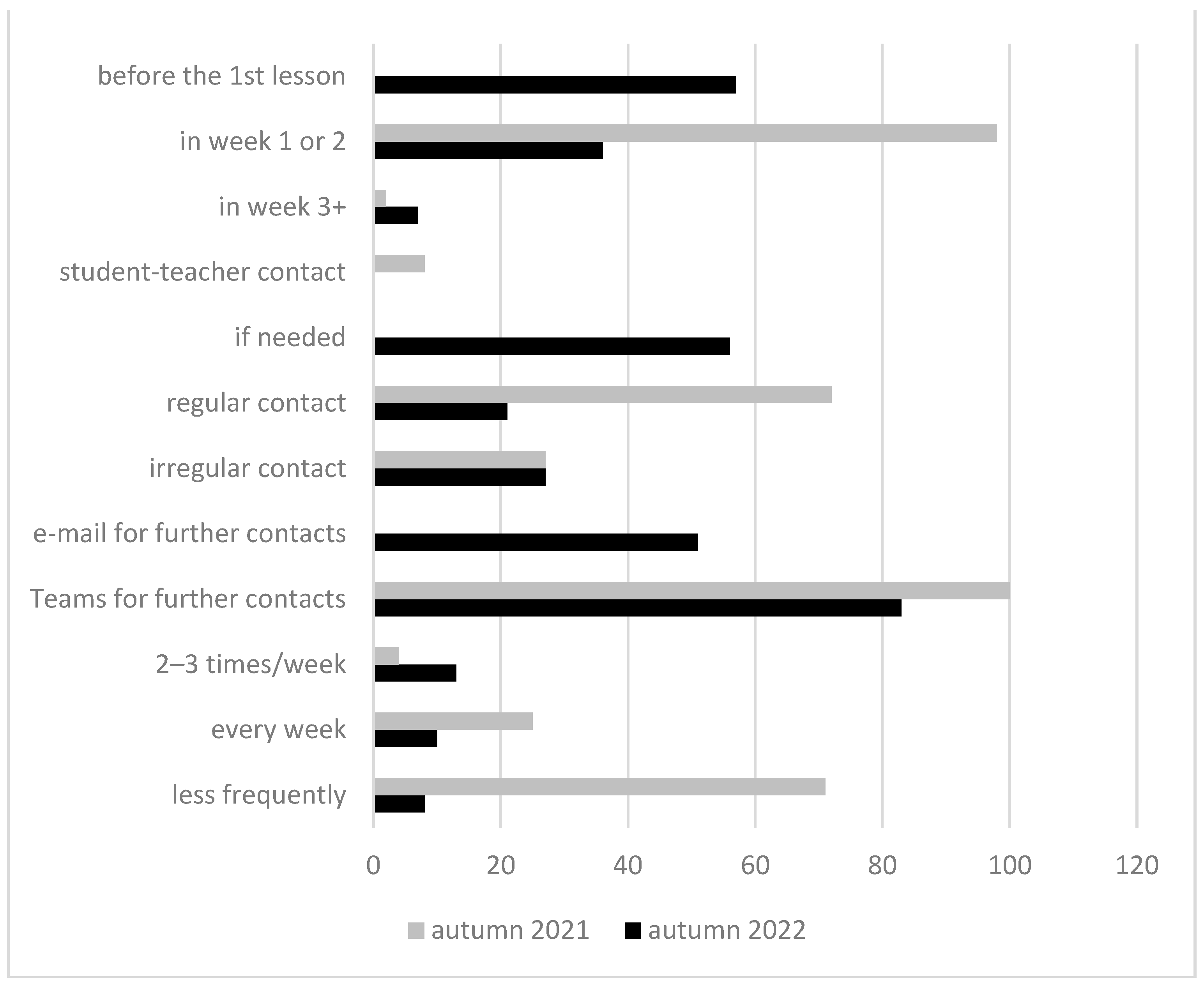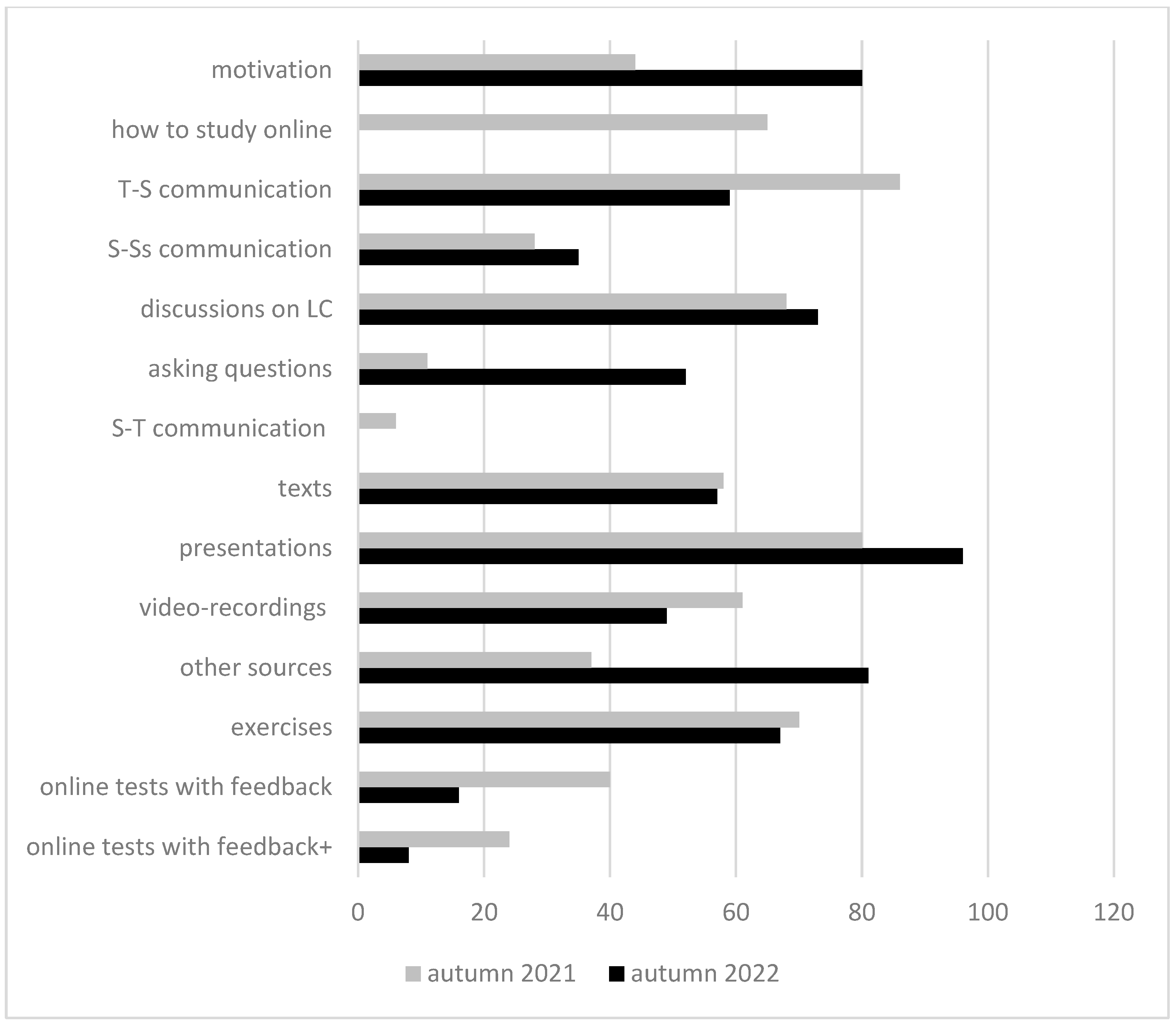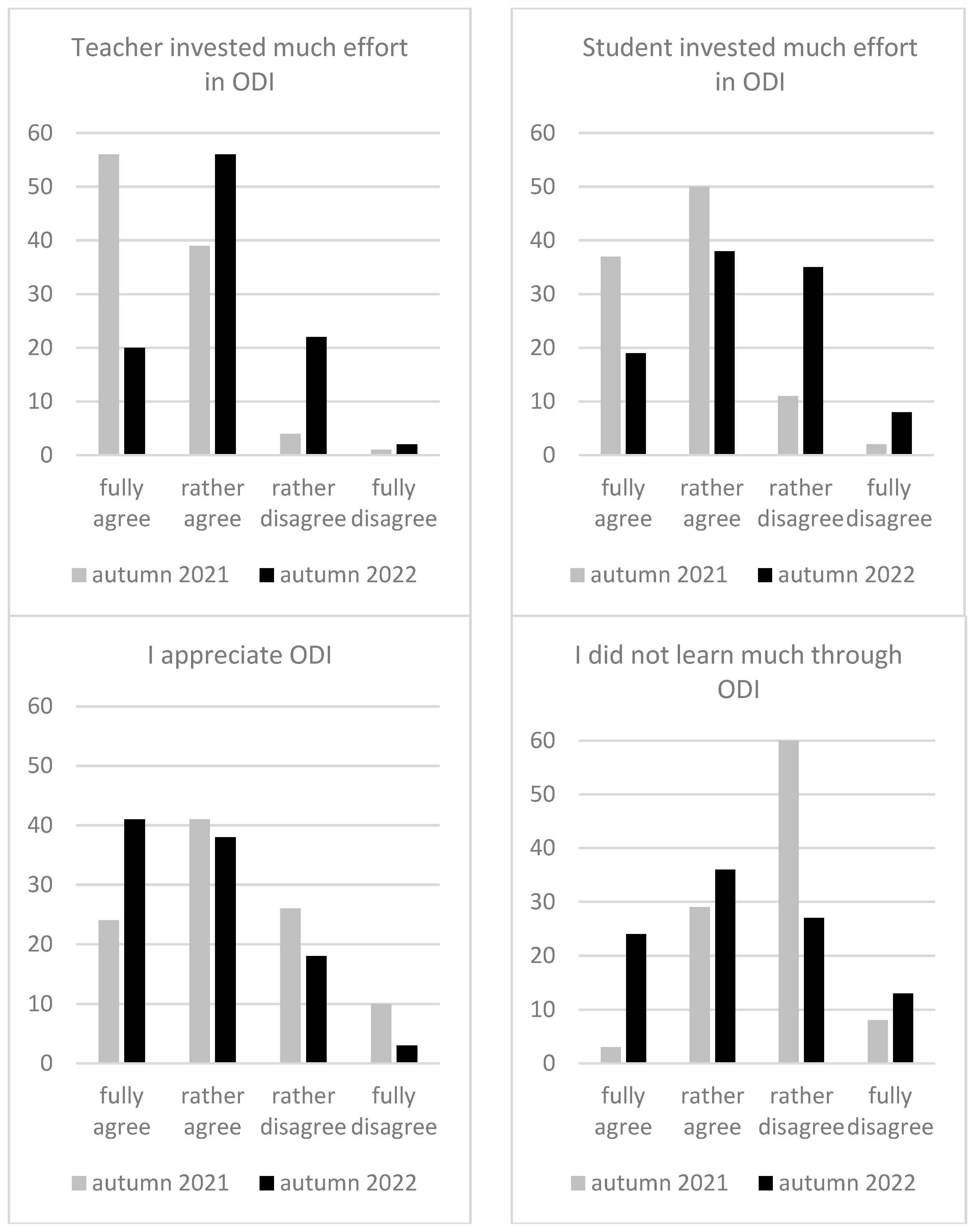New Blended Learning Enriched after the COVID-19 Experience? Students’ Opinions
Abstract
1. Introduction
1.1. The Course of Teaching and Learning under COVID-19 Restrictions in the Czech Republic
1.2. Literature Review
2. Materials and Methods
2.1. Research Question and Objective
2.2. Expectations
2.3. Research Methods and Tools
2.4. Research Sample
3. Results
3.1. The First Contact and Communication
3.2. Learning Content Acquisition
3.3. Learning Content Delivery and Assessment
3.4. Student’s Final Feedback on Online Distance Instruction
4. Discussion and Conclusions
Research Limits and Future Research
Author Contributions
Funding
Institutional Review Board Statement
Informed Consent Statement
Data Availability Statement
Conflicts of Interest
References
- IGI Global. What is Face-to-Face Instruction. Available online: https://www.igi-global.com/dictionary/face-to-face-instruction/64360 (accessed on 2 January 2023).
- Zlamalova, H. Distanční Vzdělávání a Elearning [Distance Education and Elearning], 1st ed.; J.A. Komensky University: Praha, Czech Republic, 2008. [Google Scholar]
- Hodges, C.; Moore, S.; Lockee, B.; Trust, T.; Bond, A. The Difference Between Emergency Remote Teaching and Online Learning. 2020. Available online: https://vtechworks.lib.vt.edu/bitstream/handle/10919/104648/facdev-article.pdf?sequence=1 (accessed on 2 January 2023).
- IGI Glogal. What Is Online Distance Education. Available online: https://www.igi-global.com/dictionary/online-distance-education/20962 (accessed on 6 January 2023).
- MŠMT [Ministry of Education]. Metodické Doporučení pro Vzdělávání Distančním Způsobem [Didactic Recommendation for Distance Education], 1st ed.; MŠMT: Praha, Czech Republic, 2020.
- Act N. 349/2020 Coll., § 184a Zvláštní Pravidla při Omezení Osobní Přítomnosti Dětí, Žáků a Studentů ve Školách [Changes Limiting the Present Attendance of Children, Pupils, and Students at Schools]. Available online: https://www.zakonyprolidi.cz/cs/2020-349 (accessed on 2 January 2023).
- Česká Školní Inspekce [Czech School Inspectorate]. Distance Learning in Basic and Upper Secondary Schools in the Czech Republic. Schools’ Approaches, Shifts and Experience One Year Since the Outbreak of the Covid-19 Pandemic. Czech School Inspectorate. Available online: https://www.oecd.org/education/Czech-Republic-distance-learning-in-secondary-schools-March-2021.pdf (accessed on 22 December 2022).
- MŠMT [Ministry of Education]. Principy a Zásady Úspěšného Vzdělávání na Dálku [Principles and Rules of Successful Distance Education]. 2020. Available online: https://www.msmt.cz/file/53583/ (accessed on 12 November 2022).
- OECD. Country Responses to the Coronavirus (COVID-19) Pandemic. 2020. Available online: https://www.oecd.org/education/country-education-responses-coronavirus.htm (accessed on 12 January 2023).
- Česká Školní Inspekce [Czech School Inspectorate, CSI]. Distance Learning in Basic and Upper Secondary Schools in the Czech Republic (Abridged Version for International Audience); Thematic Report; Czech School Inspectorate: Prague, Czech Republic, 2020; Available online: https://www.oecd.org/education/Czech-republic-distance-learning-in-secondary-schools.pdf (accessed on 14 December 2022).
- Neumajer, O. Vzdělávání na Dálku Přináší Zmatky v Termínech [Distance Education—Confusion in Terminology]. Available online: https://ondrej.neumajer.cz/vzdelavani-na-dalku-prinasi-zmatky-v-pojmech/ (accessed on 22 December 2022).
- Bloom, B.; Krathwohl, D.R. Taxonomy of Educational Objectives: The Classification of Educational Goals, by a Committee of College and University Examiners. Handbook 1: Cognitive Domain, 1st ed.; Longmans: New York, NY, USA, 1956. [Google Scholar]
- Cramarenco, R.E.; Burcă-Voicu, M.I.; Dabija, D.-C. Student perceptions of online education and digital technologies during the COVID-19 pandemic: A systematic review. Electronics 2023, 12, 319. [Google Scholar] [CrossRef]
- D’Arcy, C.E.; Lapsov, L.; Navarro, V.; Nevarez, D.; Olimpo, J.T. Converting a face-to-face neuroanatomy course-based undergraduate research experience (CURE) to an online environment: Lessons learned from remote teaching. Adv. Physiol. Educ. 2023, 47, 52–70. [Google Scholar] [CrossRef] [PubMed]
- Zhang, Y.; Zhang, N.; Liu, H.; Kan, Y.; Zou, Y. The impact of distance education on nursing students course performance in a sino-foreign cooperative program during the onset of COVID-19: A quasi-experimental study. BMC Nurs. 2023, 22, 16. [Google Scholar] [CrossRef] [PubMed]
- Alam, B.F.; Bashir, R.; Hussain, T.; Abbas, T.; Malik, S.A.; Jan, S.H.; Khurshid, M. Online vs. traditional learning: A comparative analysis of student’s responses during COVID-19. Work 2023, 74, 21–29. [Google Scholar] [CrossRef] [PubMed]
- Omari, H.E.; Chlouchi, K.; ZahraTalbi, F.; Benboubker, M.; Alaoui, M.M.; Lahouiti, K.; Chlouchi, A.; Maniar, S.; Merabti, A.; Taam, A.; et al. E-learning experience during covid-19 pandemic management: Perception of secondary schools teachers’ in Morocco. Sci. Afr. 2023, 19, e01536. [Google Scholar] [CrossRef] [PubMed]
- Photopoulos, P.; Tsonos, C.; Stavrakas, I.; Triantis, D. Remote and in-person learning: Utility versus social experience. SN Comput. Sci. 2023, 4, 116. [Google Scholar] [CrossRef] [PubMed]
- Overby, E. Process virtualization theory and the impact of information technology. Organ. Sci. 2008, 19, 277–291. [Google Scholar] [CrossRef]
- Alarabiat, A.; Hujran, O.; Soares, D.; Tarhini, A. Examining students’ continuous use of online learning in the post-COVID-19 era: An application of the process virtualization theory. Inf. Technol. People 2023, 36, 21–47. [Google Scholar] [CrossRef]
- Co, M.; Cheung, K.Y.C.; Cheung, W.S.; Fok, H.M.; Fong, K.H.; Kwok, O.Y.; Leung, T.W.K.; Ma, H.C.J.; Ngai, P.T.I.; Tsang, M.K.; et al. Distance education for anatomy and surgical training—A systematic review. Surgeon 2022, 20, e195–e205. [Google Scholar] [CrossRef] [PubMed]
- Othman, M.I.; Sulaiman, S.; Najib, M.N.; Ismail, W.N. Forced Online and Distance Learning during COVID-19 Pandemic: Students’ Perceptions and Experiences. Asian J. Univ. Educ. 2022, 18, 894–905. [Google Scholar] [CrossRef]
- Gnawali, Y.P.; Upadhayaya, P.R.; Sharma, B.; Belbase, S. Access, efficiency, inconvenience, and scarcity as issues of online and distance learning in higher education. Eur. J. Educ. Res. 2022, 11, 1115–1131. [Google Scholar] [CrossRef]
- Hearrington, D. Evaluation of Learning Efficiency and Efficacy in a Multi-User Virtual Environment. J. Digit. Learn. Teach. Educ. 2010, 27, 65–75. [Google Scholar] [CrossRef]
- Faltynkova, L.; Simonova, I.; Kostolanyova, K.; Klimszova, S. Re-thinking and Re-defining the Learning Process? Students’ Feedback on Online Distance Instruction. In Proceedings of the Blended Learning: Re-thinking and Re-Defining the Learning Process. 14th International Conference, ICBL 2021, Nagoya, Japan, 10–13 August 2021. [Google Scholar] [CrossRef]
- Simonova, I.; Kostolanyova, K.; Faltynkova, L.; Klimszova, S.; Guziurova, T. Online Distance Instruction in the Czech Republic During Covid-19 Pandemic: Students’ Feedback on Courses in Autumn 2021. In Proceedings of the Blended Learning: Engaging Students in the New Normal Era. 15th International Conference, ICBL 2022, Hong Kong, China, 19–22 July 2022. [Google Scholar] [CrossRef]
- Simonova, I.; Faltynkova, L.; Kostolanyova, K. Students’ Reflection on Online Distance Learning: Advantages, Disadvantages, Recommendations. In Proceedings of the Blended Learning: Re-thinking and Re-Defining the Learning Process. 14th International Conference, ICBL 2021, Nagoya, Japan, 10–13 August 2021. [Google Scholar] [CrossRef]
- Comenius, J.A. Didaktika Velka [The Great Didactics], 3rd ed.; Komenium: Brno, Czech Republic, 1948. [Google Scholar]
- Mishra, P.; Koehler, M.J. Technological Pedagogical Content Knowledge: A framework for teacher knowledge. Teach. Coll. Rec. 2006, 108, 1017–1054. [Google Scholar] [CrossRef]
- Puentedura, R. SAMR Model. Available online: https://sites.google.com/a/msad60.org/technology-is-learning/samr-model (accessed on 8 November 2022).
- Atwa, H.; Shehata, M.H.; Al-Ansari, A.; Kumar, A.; Jaradat, A.; Ahmed, J.; Deifalla, A. Online, face-to-face, or blended learning? Faculty and medical students’ perceptions during the COVID-19 pandemic: A mixed-method study. Front. Med. 2022, 93, 791352. [Google Scholar] [CrossRef] [PubMed]
- Stoian, C.E.; Fărcașiu, M.A.; Dragomir, G.-M.; Gherheș, V. Transition from online to face-to-face education after COVID-19: The benefits of online education from students’ perspective. Sustainability 2022, 14, 12812. [Google Scholar] [CrossRef]
- Mao, B.P.; Teichroeb, M.L.; Lee, T.; Wong, G.; Pang, T.; Pleass, H. Is Online Video-Based Education an Effective Method to Teach Basic Surgical Skills to Students and Surgical Trainees? A Systematic Review and Meta-analysis. J. Surg. Educ. 2022, 79, 1536–15451. [Google Scholar] [CrossRef] [PubMed]
- Simonova, I.; Faltynkova, L.; Kostolanyova, K.; Klimszova, S. Re-thinking the online distance instruction based on students’ feedback. J. Comput. High. Educ. 2022, 34, 6–39. [Google Scholar] [CrossRef] [PubMed]
- Rasli, A.; Tee, M.; Lai, Y.; Ling, T.; Zian, C.; Soon, E.H. Post-COVID-19 strategies for higher education institutions in dealing with unknown and uncertainties. Front. Educ. 2022, 731, 992063. [Google Scholar] [CrossRef]
- Wolff, L.-A. Sustainability education in risks and crises: Lessons from covid-19. Sustainability 2020, 12, 5205. [Google Scholar] [CrossRef]
- MŠMT. Spolu po COVIDu. 2021 [Together after COVID]. Available online: https://www.msmt.cz/file/55696/ (accessed on 28 February 2023).
- Czech Statistical Office. Tab. 3.2.13: Střední Odborné Vzdělávání s Maturitní Zkouškou—Žáci Podle Skupin Oborů Vzdělávání, v Časové Řadě 2011/12–2021/22. Available online: https://www.vyssiodborneskoly.com/PS/Vyssi-odborne-skoly/zdravotnicke (accessed on 4 March 2023).
- Hubacek, P. Blended Learning na Obchodní Akademii a VOŠ Valašské Meziříčí—Příprava na Distanční Vysokoškolské Stadium: [Blended Learning at Secondary Business School and Tertiary Medical School in Valašské Meziříčí—Getting Ready for University Distance Study]. TVV 2011, 4, 386–388. [Google Scholar]




| Institution | Autumn 2021 | Autumn 2022 |
|---|---|---|
| Upper secondary: Total | 104 | 128 |
| Upper secondary: Male | 9 | 9 |
| Upper secondary: Female | 95 | 119 |
| Higher education: Total | 124 | 132 |
| Higher education Male | 59 | 33 |
| Higher education: Female | 65 | 99 |
| 228 | 260 | |
| Total: | 488 | |
| Period of ODI | N | A | B | C | F | Mean Test Score (%) | Type of Assessment |
|---|---|---|---|---|---|---|---|
| Period 1 (06/20) | 20 | 3 | 2 | 13 | 2 | 72.7 | written online credit test |
| Period 1 (06/20 | 20 | 7 | 6 | 6 | 1 | - | oral f2f exam |
| Period 2 (01/21) | 19 | 12 | 3 | 4 | 1 | 82.6 | written online credit test |
| Period 3 (06/21) | 17 | 6 | 4 | 7 | 0 | - | oral f2f exam |
Disclaimer/Publisher’s Note: The statements, opinions and data contained in all publications are solely those of the individual author(s) and contributor(s) and not of MDPI and/or the editor(s). MDPI and/or the editor(s) disclaim responsibility for any injury to people or property resulting from any ideas, methods, instructions or products referred to in the content. |
© 2023 by the authors. Licensee MDPI, Basel, Switzerland. This article is an open access article distributed under the terms and conditions of the Creative Commons Attribution (CC BY) license (https://creativecommons.org/licenses/by/4.0/).
Share and Cite
Simonova, I.; Faltynkova, L.; Kostolanyova, K. New Blended Learning Enriched after the COVID-19 Experience? Students’ Opinions. Sustainability 2023, 15, 5093. https://doi.org/10.3390/su15065093
Simonova I, Faltynkova L, Kostolanyova K. New Blended Learning Enriched after the COVID-19 Experience? Students’ Opinions. Sustainability. 2023; 15(6):5093. https://doi.org/10.3390/su15065093
Chicago/Turabian StyleSimonova, Ivana, Ludmila Faltynkova, and Katerina Kostolanyova. 2023. "New Blended Learning Enriched after the COVID-19 Experience? Students’ Opinions" Sustainability 15, no. 6: 5093. https://doi.org/10.3390/su15065093
APA StyleSimonova, I., Faltynkova, L., & Kostolanyova, K. (2023). New Blended Learning Enriched after the COVID-19 Experience? Students’ Opinions. Sustainability, 15(6), 5093. https://doi.org/10.3390/su15065093









